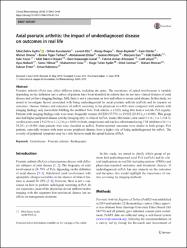Axial psoriatic arthritis: the impact of underdiagnosed disease on outcomes in real life

View/
Date
2018Author
Aydın, Sibel ZehraKüçükşahin, Orhan
Kılıç, Levent
Doğru, Atalay
Bayındır, Özün
Özişler, Cem
Kalyoncu, Umut
Tarhan, Emine Figen
Metadata
Show full item recordAbstract
Psoriatic arthritis (PsA) may affect different joints, including the spine. The prevalence of spinal involvement is variable depending on the definition and a subset of patients have been identified in cohorts that do not have clinical features of axial disease and yet have imaging findings. Still, there is not a consensus on how and when to screen axial disease. In this study, we aimed to investigate factors associated with being underdiagnosed for axial psoriatic arthritis (axPsA) and its impacts on outcomes. Disease features and outcomes of axPsA according to the physician (n=415) were compared with patients with imaging findings only (sacroiliitis fulfilling the modified New York criteria, n=112), using data from a real-life PsA registry. Patients with imaging findings only were more frequently women (83/220 (37.7%) vs 29/122 (23.8%); p=0.008). This group also had higher peripheral disease activity (imaging only vs clinical AxPsA: mean (SD) tender joint count 5.3 (6.1) vs 3.3 (4.7), swollen joint count 1.9 (2.9) vs 1.2 (2.4); p<0.001 for both comparisons) and was less often treated using TNF inhibitors (16.1 vs 38.2%; p<0.001) than patients who were classified as axPsA. Patient-reported outcomes were similar in both groups. PsA patients, especially women with more severe peripheral disease, have a higher risk of being underdiagnosed for axPsA. The severity of peripheral symptoms may be a risk factor to mask the spinal features of PsA.

















